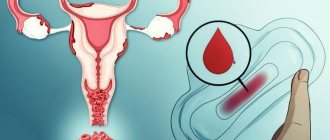Thrush with bleeding is a fairly common form of this insidious disease. But not all representatives of the fair sex know about the reasons that caused such external signs of the disease.
It is necessary to understand what the symptoms of candidiasis in women may be:
- Abundant curdled discharge (the consistency of sour cream) is white with a sour odor.
- Itchy sensations in the vulva area.
- Unreasonable urge to urinate.
Occasionally, red discharge, which is often due to the fragility of the capillaries during the development of the disease. There are additional reasons for this pathology.
It is important to consider information about why spotting occurs during thrush, and what measures should be taken if you observe similar symptomatic manifestations.
Causes
In rare cases, thrush may cause bloody discharge. They most often indicate the presence of other gynecological diseases. Common causes of this symptom include:
- ectopic pregnancy;
- erosion or fibroids of the uterus;
- hormonal imbalances;
- endometriosis.
A healthy symptom is considered only if spotting indicates menstruation. If this is not related to the cycle, then you should urgently consult a doctor, as reproductive function may be disrupted. Therefore, when thrush appears with blood, you need to make sure that it is not menstruation and only then begin treatment.
Candida fungus is present in the body of every person, but it develops only under favorable conditions. The main symptoms of thrush: curdled discharge, with itching and burning in the intimate area. Blood during thrush can occur as a symptom of an additional disease or as a complication of an ongoing disease.
Characteristic symptoms of thrush are itching, burning, and cheesy discharge. Bloody discharge is not typical for thrush
With candidiasis, the mucous epithelium often suffers. Under the plaque in the form of cheesy discharge, microcracks and ulcers can form. Depending on the volume of the lesion, a small amount of blood may be released at the site where the integrity of the epithelium is damaged. But bleeding, discharge of blood clots and copious bloody or brown discharge indicate the presence of another pathology, which requires immediate consultation with a doctor.
A weakened immune system is the main trigger for the development of thrush in the vaginal mucosa.
Also, the causes of candidiasis with bloody discharge include:
- allergies to low-quality and unnatural underwear or pads;
- allergies to intimate and personal hygiene products;
- pregnancy;
- weakened immune system;
- disruption of the endocrine system (development of diabetes mellitus);
- the beginning of menstruation;
- increased moisture levels, which provokes the development of candidiasis;
- increased acidity in the mucous membrane due to improper use of intimate hygiene products;
- restoration of the body after operations or recovery from serious illnesses;
- consequences after taking antibiotics, hormonal or contraceptive drugs;
- the appearance of erosion after rough sexual intercourse or excessive dryness in the vagina.
Prevention
Regularly changing pads helps prevent thrush
Women can prevent recurrences of vaginal candidiasis with the following recommendations:
- do not use scented sanitary products such as pads or tampons;
- Dry your intimate area well after showering or bathing;
- do not stay in wet clothes for a long time, for example after swimming in the pool or grueling workouts in the gym;
- avoid douching, as this can upset the balance of “good” and “bad” bacteria in the vagina;
- change tampons and pads every 4–8 hours;
- wear cotton underwear that does not fit tightly to the skin and thus provides free access to air;
- after using the toilet, wipe in the direction from the pubis to the back;
- control blood sugar levels if you have diabetes.
Pregnancy
Candida fungus is always present, but it begins to act actively only under favorable conditions. There is a change in acidity in the mucous membrane, after which the fungus begins to multiply. This phenomenon is called thrush. It can also develop in a pregnant woman. The main reasons for the development of candidiasis during pregnancy include:
- the use of underwear made from synthetic artificial material, which makes it impossible for the skin to “breathe”. It is recommended to use cotton underwear.
- rough sex, which results in microcracks in the mucous membrane or infection.
- weak immune system during pregnancy.
- use of medications without prescription or supervision of the attending physician.
- lack of vitamins or other useful elements.
- poor nutrition.
- hormonal imbalance.
Bloody discharge during pregnancy is a reason to immediately consult a doctor.
A timely visit to the doctor and examination will help get rid of thrush and bear a healthy baby.
Preventive measures
Candidiasis is a disease that can be prevented by following basic preventive measures. These preventive measures include recommendations from gynecologists, adherence to good hygiene and proper diet.
- Hygiene. It is recommended to change underwear in a timely manner and carry out hygiene procedures with special detergents, including lactic acid. It is not advisable to use detergents with aggressive composition.
- Underwear. Gynecologists note that underwear should be made from natural fabrics. Tight synthetic underwear promotes the development of candidiasis.
- Nutrition. The daily diet must include lactic acid products and fresh vegetables. During treatment, sweet foods and confectionery products should be excluded.
If the first signs of candidiasis occur, as well as blood in the cervical mucus, you should promptly contact a gynecologist.
Taking oral contraceptives
A woman's body has a natural balance of estrogen and progesterone. Their number depends on the phase of the menstrual cycle. During thrush, estrogen is produced in large quantities before menstruation; if the woman is not pregnant, then menstruation begins. When taking contraceptives, the body does not have enough hormones that inhibit the production of estrogen. This can cause bleeding during thrush.
If the body does not adapt to hormonal drugs, as a result of which blood appears, it is necessary to urgently consult a gynecologist.
In addition to bleeding after taking contraceptives, thrush may cause:
- pain in the ovarian region;
- chest pain;
- nagging pain during exercise;
- discomfort during coitus.
Types of discharge for thrush
The discharge may have different colors and consistency. If the secretion secreted by thrush is white, has a cheesy consistency, and the smell of the discharge is similar to rotten fish, this means that the circulatory system is not affected, and thrush is only a concomitant pathology of the uterus.
I would like to draw your attention to the fact that 2-4 days after the end of your period, the color of the discharge may change to brown, but later it will turn white again. The duration of this stage mainly depends on the strength of the immune system and the amount of pathogen that has reached the mucous membranes.
Bloody discharge from thrush appears when the disease becomes acute. At the same time, they first become pink, which is already the first sign of damage to the blood vessels of the vaginal wall, and if left untreated for a long time, the discharge can become bloody.
Treatment
To stop bleeding, it is necessary to first identify the cause of its occurrence. In the acute form of the disease, the infection is cleared much easier for the first time than in the chronic form. However, the treatment process becomes significantly more complicated with complications such as discharge with blood and itching. Along with such symptoms, diabetes mellitus, intestinal dysbiosis and other diseases can develop.
To eliminate this unpleasant and dangerous symptom, you need to change your diet, follow all the rules of intimate hygiene, stop having sex for a while, and also stop taking antibiotics. Candidiasis can only be cured with antifungal agents. Only the attending physician can prescribe medications, based on tests, the nature of the disease and the individual characteristics of the patient.
Any treatment methods require prior approval from the attending physician. Self-medication can be dangerous
Often, ointments, creams and suppositories are effective. They do not cause adverse reactions, they fight infection, and also reduce symptoms. Thanks to its anti-allergenic properties, it relieves pain, itching and burning in the vaginal area. Treatment must be carried out in a timely manner in order to prevent the chronic form of the disease. Most often, experts recommend the following drugs:
- Nystatin;
- Flucostat;
- Clotrimazole;
- Candide;
- Diflucan
- Polygynax;
- Terzhinak.
Medicines should only be taken with a prescription from a doctor, since self-medication can lead to a worsening of the situation, which can lead to complications or the development of new diseases.
Literature:
- Modern principles of diagnosis and treatment of vaginal candidiasis. Evseev A.A.
- Vaginal candidiasis. Possibilities of drug therapy. Makarov I.O. Sheshukova N.A.
- Current approaches to the diagnosis and treatment of sechostatic candidiasis in women with an understanding of the peculiarities of the clinical transition and disruption of the microflora of the ear and intestines. Stepanenko V. I. Konovalova T. S.
- Malbakhova E.T. Clinical course and features of local immunity in vulvovaginal candidiasis in pregnant women: Dis. ... Candidate of Medical Sciences - M., 2009. - 128 P.
- Krasnopolsky V.I. Treatment and prevention of chronic vaginal candidiasis against the background of sexually transmitted infections / V.I. Krasnopolsky, O.F. Serova, N.V. Zarochentseva // Russian Bulletin of Obstetrician-Gynecologist. – 2003. – No. 6. – P. 54 – 57.
- Karapetyan T.E., Tyutyunnik B.JI. Modern aspects of the treatment of vulvovaginal candidiasis // Russian Medical Journal. – 2004. -T. 12., No. 13.-S. 33 – 3
- Vaginal candidiasis. Modern approach to solving the problem / O.F. Serova [and others] // Issues of gynecology, obstetrics and perinatology. – 2006. – T.5., No. 3. – P. 67 – 72.
- Baranov I.I. Ecology of the vagina and inflammatory diseases of the genital organs // Gynecology. – 2010. – T. 12., No. 3. – P. 4 – 6.
- Arabian PA, Klimko HH, Vasilyeva N.V. Diagnosis of mycoses. - St. Petersburg, 2004.- 185 S.
Diagnostics
The fungus of the Candida family, which causes thrush, can include chlamydia, herpes virus, ureaplasma, trichomonas, streptococci, staphylococci and a number of other pathogenic organisms.
To diagnose concomitant infections and thrush itself, the following methods are used:
- Smear of the vaginal walls for bacteriological culture. The microflora taken by smear is grown in special laboratory conditions, then examined microscopically to identify the qualitative composition of the microflora.
- Urinalysis - allows you to identify fungal and other infections in the urethra, since waste products and fungal spores are washed away along the canal with urine.
- A general blood test - a study of the concentration of erythrocytes, leukocytes and erythrocyte sedimentation rate makes it clear about the development of the inflammatory process caused by thrush.
These methods are usually sufficient to confirm the diagnosis established by the gynecologist during examination of the patient.
What to do?
Usually, to eliminate bloody impurities, it is enough to cure the underlying disease. Restore normal microflora in the vagina using local means.
Pimafucin
The most effective is Pimafucin with the active ingredient natamycin. It is well tolerated and does not cause allergies. It is used in pregnant and nursing mothers, but treatment with Pimafucin is interrupted during menstruation. Directions for use: one suppository per week.









